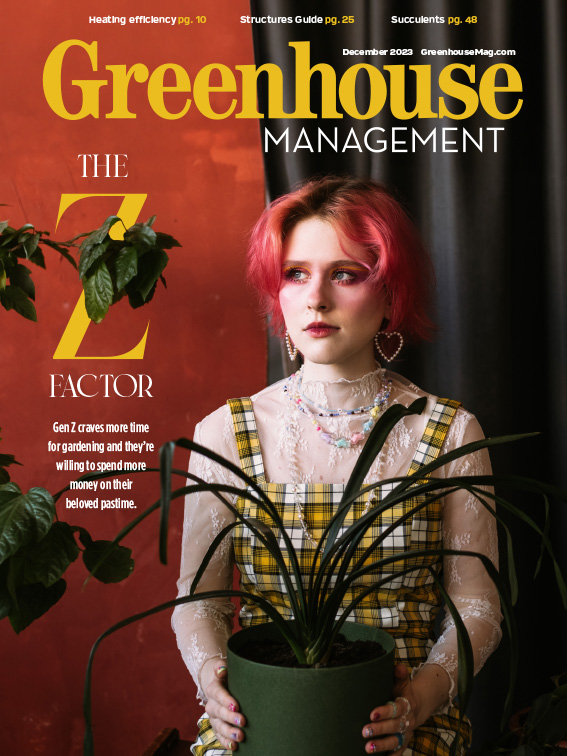Part of owning and operating a greenhouse business is improving and maintaining the facility. That means improving existing structures, building new ones when necessary and upgrading the technology inside the facility.
Here are three recent stories from the pages of Greenhouse Management about growers who have upgraded their structures and invested in their businesses to take them to the next level. And if you’re business is working on its own expansion, we’d love to hear about it — drop manager editor Chris Manning a line at cmanning@gie.net and let us know.

Harster Greenhouses
Company owner Yannick Harster attributes part of the company’s success to an embrace of technology across all operations. With nearly 50 years in the tissue culture space, the business enjoys a “first-mover advantage” through new product categories created at an off-site lab. Instead of breeding or propagating via cuttings or other techniques, lab engineers harness in-vitro technology to clean, initiate, select and reproduce genetic material.
“This way, we have more control over aesthetic quality, growth cycles and plant hardiness,” Harster says.

Meanwhile, a lab entomology arm allows the company to produce biocontrols — among them nematodes and various predatory insects — that it then applies in its greenhouses. Technicians use laboratory equipment to identify harmful pathogens, providing rapid remediation before an infection can spread.
Harster says, “These aspects of our laboratory’s integration have taken on an even greater importance and value due to the supply chain issues all industries are currently facing. It allows us a degree of self-sufficiency that not many growers benefit from, and we’re fortunate our founders pursued this venture.”

Green Circle Growers
Part of Marcel Boonekamp’s job is blending his Dutch background with North American-style greenhouse growing. It can be challenging to mesh, he says, because the markets are so different. But a program like Green Circle Growers’ orchid program is somewhat fashioned after the Dutch model of dialing in one specific crop. They also use a Dutch greenhouse manufacturer, various Dutch suppliers and Dutch breeders.
“We want to be on the forefront of new technology — if it makes sense, if it’s manageable,” Boonekamp, who works as Green Circle’s director of growing.

Part of keeping up to date on technology are multiple trips a year to the Netherlands to visit growers and attend trade shows. There, Marcel does his version of what he saw his father do while he was growing up: network, learn from others in the field and take lessons back to Green Circle.
“I do those trips to see new things, to see new people, to talk to people, to stay in touch with exactly what I started with growing up,” he says. “That makes you better, makes you sharper.”
When he goes on trips, Marcel often brings other Green Circle employees with him so they can learn along with him.“[New production information] can be hard to explain sometimes,” he says. “I’ve seen that bringing people along and then coming back from the trip they’ll be like ‘ah, now I know why we are looking at that.’ It’s all about letting people see why I’m looking at something a certain way or want to change something. Otherwise, people only see Green Circle, right? We are diverse, but they have to see something else to be open minded and get the broader picture.”
Corwin Graves, Green Circle’s VP of growing, adds that the way Marcel runs his team provides a good model for other managers. The Green Circle orchid program, he says, helped them sell other crops (namely foliage) because the orchid quality was so high.
“We are looking to implement what he does into other areas,” Corwin says. “He’s brought a level of professionalism that I’d like to see brought into the other greenhouse areas.”

Westerlay Orchids
Toine Overgaag, owner of Westerlay Orchids, emphasizes articulating the company vision and setting conscious, intentional goals. Westerlay is now four years into a detailed seven-year plan that includes some new products and doubling production.
“I think part of growing up as an organization is being very deliberate about the goals you set, and about moving towards those and communicating it as a team and delegating responsibility for achieving those goals throughout a team,” Toine shares.
Production goals include overall numbers and how they’re achieved. Most U.S. orchids are grown in Taiwan from tissue culture until the finishing stage, with only the flowering phase happening here. Toine estimates that model describes half of all U.S. orchids and two-thirds of California’s.
But Westerlay is different: It receives tissue cultures and grows its orchids “from flask to flower,” producing finished plants in 17-18 months. “To my knowledge, in North America, there’s only two or maybe three other major growers who do that,” Toine says.

The choice has pros and cons. Costs and risks are much higher. But increased control allows Westerlay to capitalize on market trends and minimize disruptions.
“Now we’re able to control exactly which varieties we grow and when we’re flowering them, so that we can hit market peaks,” Toine explains. Noting pandemic shipping upheavals, he adds, “That was something we never had to deal with. We were always able to control when our product was flowering and make sure that they got to the customers when they wanted it.”
Two-inch mini orchids are an exception, but that’s changing soon. At year’s end, Westerlay will transition its minis to “flask to flower” production and gain home court advantage for that category, too.
Another deliberate goal from Westerlay’s seven-year plan is to work more with partners to significantly reduce its carbon footprint.
Toine acknowledges that a farmer never wants to spend more on inputs than necessary, but his motivation transcends that: “I think for me personally, and us organizationally, we have become much more focused on externalities and climate change and what we can do.”
With changing technology, he believes many opportunities for improved sustainability exist that also make economic sense. “The paybacks can sometimes be pretty long, but the paybacks are there,” he says.

Explore the December 2023 Issue
Check out more from this issue and find you next story to read.
Latest from Greenhouse Management
- Landmark Plastic celebrates 40 years
- CropLife applauds introduction of Miscellaneous Tariff Bill
- Greenhouse 101 starts June 3
- Proven Winners introduces more than 100 new varieties for 2025
- UF/IFAS researchers work to make beer hops a Florida crop
- CIOPORA appoints Micaela Filippo as vice secretary-general
- Passion grows progress
- Registration opens for Darwin Perennials Day





